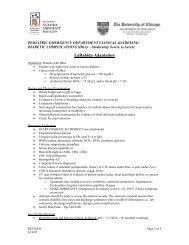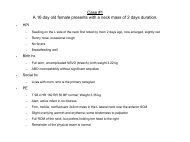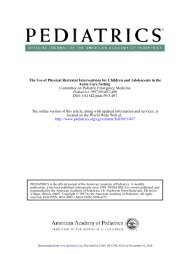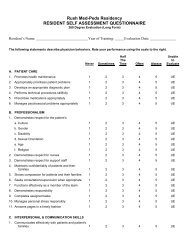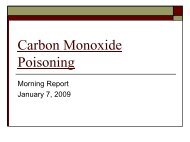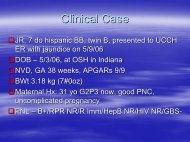the Rochester criteria - Department of Pediatrics
the Rochester criteria - Department of Pediatrics
the Rochester criteria - Department of Pediatrics
Create successful ePaper yourself
Turn your PDF publications into a flip-book with our unique Google optimized e-Paper software.
smear. Cultures <strong>of</strong> stool specimens from two <strong>of</strong> <strong>the</strong>se<br />
infants revealed no pathogens, no stool specimen<br />
was sent for culture from <strong>the</strong> third infant, and both<br />
Salmonella sp. and Yersinia enterocolitica were isolated<br />
from a stool specimen from <strong>the</strong> fourth infant. Salmonella<br />
enteritidis was isolated from stool specimens<br />
from three additional infants. Stool smear results<br />
were not recorded for two infants, and one had a<br />
normal stool smear. All four infants with bacterial<br />
gastroenteritis had ei<strong>the</strong>r an abnormal peripheral<br />
blood WBC count, band form count, or both.<br />
DISCUSSION<br />
A recent meta-analysis <strong>of</strong> studies <strong>of</strong> febrile infants<br />
60 days <strong>of</strong> age showed that infants meeting <strong>the</strong><br />
<strong>Rochester</strong> <strong>criteria</strong> had a lower probability <strong>of</strong> having<br />
SBI than if o<strong>the</strong>r strategies were employed.21 The<br />
present study prospectively evaluated a large number<br />
<strong>of</strong> febrile infants to fur<strong>the</strong>r test <strong>the</strong> ability <strong>of</strong> <strong>the</strong><br />
<strong>Rochester</strong> <strong>criteria</strong> to accurately identify infants unlikely<br />
to have SB!. The negative predictive value <strong>of</strong><br />
<strong>the</strong> <strong>Rochester</strong> <strong>criteria</strong> was chosen as <strong>the</strong> most appropriate<br />
test to identify infants unlikely to have SB!. The<br />
95% confidence interval for <strong>the</strong> negative predictive<br />
value <strong>of</strong> <strong>the</strong> <strong>Rochester</strong> <strong>criteria</strong> for SB! (97.2% to<br />
99.6%) and for bacteremia (98.2% to 99.9%) confirm<br />
<strong>the</strong> ability <strong>of</strong> <strong>the</strong> <strong>Rochester</strong> <strong>criteria</strong> to identify febrile<br />
infants unlikely to have SB!.<br />
Because <strong>the</strong> <strong>Rochester</strong> <strong>criteria</strong> were designed to<br />
identify infants unlikely to have SB!, only well appearing<br />
infants were included in <strong>the</strong> present study.<br />
By excluding ill appearing infants from <strong>the</strong> study<br />
population, <strong>the</strong> prevalence <strong>of</strong> SB! in our study is<br />
lower than that observed in previous studies (7% vs<br />
9%)9 While <strong>the</strong> negative predictive value <strong>of</strong> <strong>the</strong><br />
<strong>Rochester</strong> <strong>criteria</strong> may be lower when <strong>the</strong> <strong>criteria</strong> are<br />
applied to a population including ill appearing infants<br />
(higher prevalence <strong>of</strong> SB! in this group), it is<br />
most appropriate to apply <strong>the</strong> <strong>Rochester</strong> <strong>criteria</strong> only<br />
to well appearing febrile infants. Although not stated<br />
as a criterion in early studies,16”8 ill appearing infants<br />
have always been excluded when evaluating <strong>the</strong> low<br />
risk <strong>criteria</strong>. Most investigators agree that ill appearing<br />
infants have a higher likelihood <strong>of</strong> SB! than well<br />
appearing infants,13’4’6’7 and <strong>the</strong>re is little controversy<br />
regarding <strong>the</strong>ir management. The consensus is that<br />
such infants should be hospitalized and treated with<br />
antimicrobial <strong>the</strong>rapy regardless <strong>of</strong> <strong>the</strong> remainder <strong>of</strong><br />
<strong>the</strong>ir evaluation.<br />
The present study shows that among well appearing<br />
infants <strong>the</strong> <strong>Rochester</strong> <strong>criteria</strong> work well. We believe<br />
<strong>the</strong> narrow confidence interval around <strong>the</strong> negative<br />
predictive value <strong>of</strong> <strong>the</strong> <strong>Rochester</strong> <strong>criteria</strong><br />
supports <strong>the</strong> clinical use <strong>of</strong> <strong>the</strong>se <strong>criteria</strong>.<br />
Management <strong>of</strong> Infants Who Meet <strong>the</strong><br />
<strong>Rochester</strong> Criteria<br />
Our data strongly suggest that infants who meet<br />
<strong>the</strong> <strong>Rochester</strong> <strong>criteria</strong> can be carefully observed without<br />
parenteral antimicrobial agents. Over one-third<br />
<strong>of</strong> <strong>the</strong> low risk infants in <strong>the</strong> present study were not<br />
initially treated with antimicrobial <strong>the</strong>rapy, and all<br />
did well. Four <strong>of</strong> five low risk infants with SB! did<br />
not receive antimicrobial <strong>the</strong>rapy until cultures be-<br />
394 FEBRILE INFANTS AT LOW RISK FOR SBI<br />
came positive. With careful observation and followup,<br />
appropriate <strong>the</strong>rapy was initiated when SB! was<br />
diagnosed and no infant experienced untoward effects.<br />
One low risk infant with N. meningitidis bacteremia<br />
initially received antimicrobial <strong>the</strong>rapy, and<br />
<strong>the</strong> outcome <strong>of</strong> this particular infant without antimicrobial<br />
<strong>the</strong>rapy remains unknown. It has been<br />
shown, however, that in some cases bacteremia with<br />
this organism has resolved without antimicrobial<br />
<strong>the</strong>rapy. O<strong>the</strong>r investigations support observation<br />
for low risk infants. In a study by Wasserman et aP5<br />
five infants less than 3 months <strong>of</strong> age were hospitalized<br />
and observed without antimicrobial <strong>the</strong>rapy un-<br />
61 cultures <strong>of</strong> blood (I), urine (3), and stool (1) were<br />
reported positive for bacterial pathogens. Outcomes<br />
“did not appear to be altered by <strong>the</strong> delay in diagnosis<br />
and treatment”.’5 A recent study by Baker et<br />
aP also demonstrated that selected febrile infants 29<br />
to 56 days <strong>of</strong> age may be managed without antimicrobial<br />
<strong>the</strong>rapy.<br />
An alternative strategy for <strong>the</strong> management <strong>of</strong> <strong>the</strong><br />
low risk febrile infant is to administer a single dose <strong>of</strong><br />
intramuscular ceftriaxone following a complete laboratory<br />
evaluation for suspected sepsis (cultures <strong>of</strong><br />
specimens <strong>of</strong> blood, CSF, and urine (obtained by<br />
bladder tap or ca<strong>the</strong>terization)) and to provide as<br />
careful outpatient follow-up as possible. This approach<br />
was studied in infants 60 days <strong>of</strong> age by<br />
McCarthy et aP9 with no bad outcomes. Baskin et a124<br />
also managed selected febrile infants between 28 and<br />
89 days <strong>of</strong> age as outpatients following a single dose<br />
<strong>of</strong> intramuscular ceftriaxone. All <strong>of</strong> <strong>the</strong> infants with<br />
SBI subsequently received appropriate antimicrobial<br />
<strong>the</strong>rapy and except for a 7-day delay in <strong>the</strong> diagnosis<br />
<strong>of</strong> osteomyelitis in one patient, all were well at follow-up.<br />
Outpatient management <strong>of</strong> selected febrile<br />
infants with a single dose <strong>of</strong> intramuscular ceftriaxone<br />
was found to be cost effective as analyzed by<br />
Lieu et al?- This strategy mandates that a lumbar<br />
puncture be done and blood, CSF, and urine specimens<br />
be obtained for culture.<br />
It is important to recognize that <strong>the</strong> administration<br />
<strong>of</strong> parenteral antimicrobial agents to a febrile infant<br />
is not a substitute for careful observation. The decision<br />
to observe a low risk febrile infant at home with<br />
or without administering a parenteral antimicrobial<br />
agent should be made only after careful assessment<br />
<strong>of</strong> <strong>the</strong> caregiver and guaranteeing <strong>the</strong> availability <strong>of</strong><br />
a responsible physician. The caregiver must appreciate<br />
that <strong>the</strong> infant’s condition may change and<br />
should be told what to watch for and when to call.<br />
Parents <strong>of</strong> infants managed as outpatients can be<br />
given written instructions to assess <strong>the</strong> infant at least<br />
every 4 hours and to call <strong>the</strong> physician for any concerns<br />
or for any changes, such as onset or change in<br />
skin rash, cyanosis or mottling, poor feeding or vomiting,<br />
difficulty consoling or arousing, jerking movements<br />
or eye rolling, or bulging fontanelle. Caregivers<br />
should have a telephone, have <strong>the</strong> telephone<br />
number <strong>of</strong> <strong>the</strong> responsible physician, and if <strong>the</strong> infant’s<br />
condition changes, be able to meet <strong>the</strong> physician<br />
within 30 minutes. Obviously, such rigid standards<br />
cannot be met in many urban Emergency<br />
Downloaded from<br />
www.pediatrics.org.<br />
Provided by UNIV OF CHICAGO on November 10, 2010







